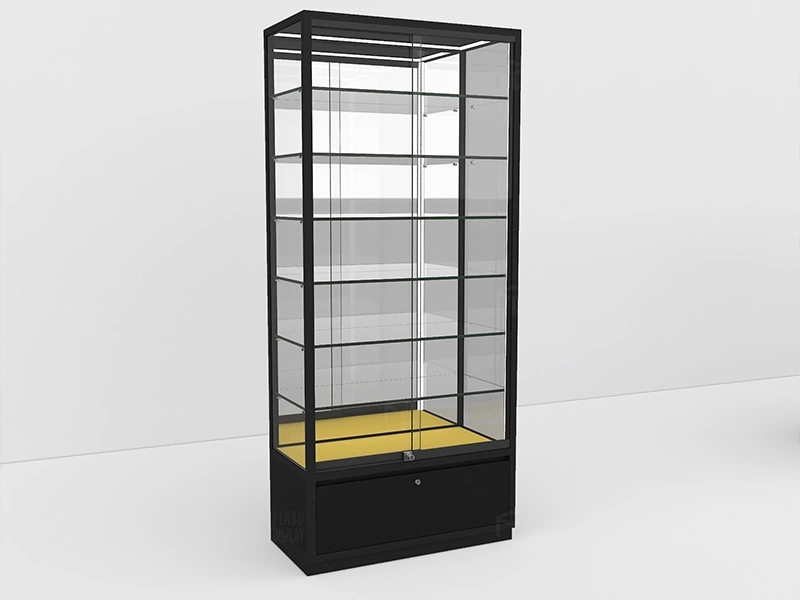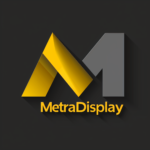
Smart store layouts can boost sales anywhere from 80% to 478%. Display materials are vital to creating retail environments that grab customer attention and influence buying decisions. Strategic display placement can increase revenue by 11.15%. This shows why picking the right materials for your store’s fixtures matters so much.
Your choice of display material shapes both how your store works and looks. Corrugated cardboard works great for seasonal promotions. Metal displays give a modern feel to electronics and fashion items. Stainless steel merchandise racks resist damage from air, steam, and water. Aluminum components help display stands keep their shape when under pressure. So knowing the different types of retail displays and when to use them helps store owners build better shopping spaces.
This piece covers everything you need to know about picking display materials. We look at durability, weight limits, visual appeal, and economical solutions. You’ll find how different materials help create retail display units that show products at their best and handle busy store traffic. The right display materials can reshape the scene of retail spaces. They create welcoming, organized shopping environments that improve customer experience and boost sales.
Understanding the Role of Display Materials in Retail

Display materials serve as silent brand ambassadors in retail environments. They shape everything from how customers see products to how they behave while shopping. A shopper’s attention span lasts only seconds in a busy store, making first impressions crucial to purchase decisions. The right materials can turn basic product displays into powerful tools that drive sales.
Why material choice impacts product visibility
The materials you choose for displays do more than hold products—they tell customers about your brand’s quality and values. Glass fixtures give off a modern, luxurious feel that works great for high-end products. Wooden displays create a warm, crafted look. The Retail Design Institute’s research shows stores that use premium materials like ornate metalwork build better connections with wealthy shoppers.
Products stand out best when they contrast with their backdrop. Displays that showcase products with eye-catching colors and graphics lead to both planned and impulse purchases. This boosts a store’s profits. Displays placed in busy areas can stop shoppers in their tracks, giving brands the perfect chance to get their message across.
How display materials affect customer experience
Display materials shape the shopping trip in both mental and practical ways. People are visual creatures by nature, and point-of-purchase displays tap into this aspect of human psychology. These displays use visuals and messages to influence shoppers before they even realize it.
Great display designs trigger emotions through their materials. Wood brings warmth, metal adds sleekness, and acrylic offers clarity. These materials connect with shoppers and make their experience more memorable. A store layout with clear signs and well-placed displays helps customers move through easily. This cuts down on frustration and makes them want to explore more.
Hands-on displays that let customers touch and try products boost overall shopping satisfaction. This hands-on aspect matters most for items where quality matters in the buying decision. Well-designed fixtures use smart positioning, lighting, and display techniques to highlight new or featured products. This creates excitement and makes people more likely to buy.
Balancing esthetics and durability in store fixtures
The best retail displays look great and last long. A display must handle the demands of retail life, no matter how good it looks—this matters most in busy areas. Materials like tempered glass, metal, or sustainable wood look high-end and stay strong with regular use.
Durability means more than just strength. High-traffic areas need materials that can take daily wear and tear, from floors to shelves. Premium materials might cost more upfront, but save money over time. They last longer and need less maintenance.
Different store sections need different approaches. Corrugate works great for short-term or seasonal displays because it’s light and budget-friendly. Wood, metal, and acrylic fit better as permanent fixtures when you want a premium look. Your choice depends on your budget, how long the display needs to last, and your brand’s image.
Types of Display Materials and Their Use Cases

The right display materials are the foundation of retail merchandising that works. Different materials have unique properties that make them suitable for various retail environments, product types, and promotional strategies.
Corrugated Cardboard for Temporary Promotions
Corrugated cardboard is the top choice for short-term, seasonal promotions and new product launches. This lightweight material is an economical solution compared to permanent fixtures, making it perfect for budget-conscious store owners. We used corrugated displays mainly for temporary setups because they’re easy to move, set up, and take down. These displays are also recyclable and made through eco-friendly processes, which appeals to brands focused on sustainability.
Powder-Coated Metal for Long-Term Durability
Powder-coated metal is your best bet when you need displays that last. Unlike liquid paint, powder coating uses dry powder that’s applied electrostatically and heated to create a protective “skin”. This creates a tough finish that holds up against shopping cart bumps and heavy use. Powder-coated metal fixtures keep looking great over the last several years, and retailers say they retain 95% of their original appearance after two years of heavy use.
Wire Mesh for Modular Merchandise Display Racks
Wire mesh display racks give you unmatched flexibility in showing products. These economical structures adapt to your changing retail needs with their modular design. Retail experts say wire displays keep their shape even with heavy items while letting customers see products from every angle. These racks work great as standalone units or wall fixtures, helping retailers make the most of their floor and wall space.
Acrylic and PVC for Lightweight Retail Display Units
Acrylic displays combine toughness with style and give products crystal-clear visibility. You can use these fixtures anywhere – from countertops to wall mounts. They usually last 1-3 years, hitting the sweet spot between cost and durability. Their see-through design is a great way to get the most visibility, especially when you have jewelry, cosmetics, and electronics to showcase.
Glass for High-End Product Showcases
Glass display cases create that unmistakable premium feel your high-value merchandise needs. These fixtures use tempered glass for strength and often come with LED lighting to make products pop. You’ll find sophisticated locks that keep valuable items secure while customers can still see them. Wall-mounted models with mirrored backs let customers see products from all angles without touching them—perfect for delicate or expensive items.
Wood and MDF for Natural and Composite Fixtures
Wood displays bring warmth and natural beauty that show quality craftsmanship. Medium-density fiberboard (MDF) offers a consistent density throughout, unlike natural wood with its knots and grain patterns. MDF works perfectly for precise cuts and detailed retail fixtures. While it needs to stay indoors and requires proper care, its smooth surface takes all kinds of finishes from high-gloss paint to wood veneers, so you can match any store’s look.
Choosing the Right Material Based on Store Needs

Retail stores just need smart material choices that match their specific requirements. Good looks matter, but practical factors determine how well displays work in real-world conditions.
Weight-bearing capacity and product type
Display materials and merchandise must work together for successful retail design. Standard flat display shelves can hold 35 pounds per square foot with a shelf deflection of 1/4″ under weight. Metal provides better structural integrity for heavy items like electronics or bottled drinks.
Materials handle weight differently. Corrugated cardboard works well for specific loads when designed properly. Products can get damaged, and safety risks increase if weight limits are exceeded. Powder-coated metal fixtures offer great strength compared to their weight and work best for heavy merchandise in busy areas.
Environmental conditions: humidity, temperature, traffic
Store conditions affect how materials perform and last. Displays in humid spots must resist moisture absorption because cardboard breaks down in wet conditions. Store fixtures must handle specific challenges:
- UV exposure: Materials with UV inhibitors work best in sunny spots to stop fading
- Temperature changes: Materials expand and contract differently
- Traffic patterns: Busy areas work better with powder-coated metal fixtures that hide fingerprints and resist chipping
Metal base cabinets provide strength to support heavy appliances where people shop. Stainless steel works great in food and drink areas because it stays clean.
Brand identity and visual merchandising goals
Display materials should line up with the brand image and help merchandise look better. Quality materials show customers your steadfast dedication to excellence. To name just one example, luxury retailers often pick glass or premium acrylic to look sophisticated, while eco-friendly brands might use reclaimed wood or bamboo.
Visual merchandising displays change how people buy a lot. Sales can increase when fixtures match brand identity instead of using basic metal shelves. More than that, sign kits aid brand awareness and customer loyalty.
The best displays let people browse easily while looking great. Smart fixture placement shows off valuable merchandise, and sales increase when the materials balance looks and purpose.
Layout and Placement Strategies for Display Fixtures

Display materials in retail spaces need careful planning to enhance visibility and make products available. Well-placed fixtures showcase products and guide shopping behavior throughout the store.
Using wall-mounted racks to optimize vertical space
Wall-mounted racks provide expandable solutions for retail environments. These fixtures help stores maximize their vertical storage potential and create visually appealing merchandise arrangements. The systems transform unused wall areas into valuable merchandising space without taking up floor area. Store owners can display more products within the same footprint. This benefit becomes crucial in smaller retail spaces where space efficiency matters most.
Free-standing units for 360-degree accessibility
Free-standing display units (FSDUs) let customers view products from every angle. These standalone fixtures grab attention and draw customers’ eyes to featured items and promotions. Shoppers interact with an FSDU five times more often than with in-aisle products. These units perform best in high-traffic areas or aisle ends where customers naturally pause. This placement boosts visibility and drives impulse purchases.
ADA compliance: 3.5 feet aisle spacing rule
Store layouts must follow specific standards for accessibility. Aisles need a minimum width of 36 inches (3 feet) to accommodate wheelchair users and mobility devices. Experts suggest 3.5-foot-wide aisles for optimal comfort. This width allows easy passage for strollers, wheelchairs, and multiple browsing customers. Pathways must stay clear – no objects should stick out more than four inches into walkways.
Traffic flow patterns: clockwise movement optimization
Customer movement patterns help determine smart fixture placement. Retail anthropologist Paco Underhill discovered that shoppers typically turn right when entering a store and move counterclockwise. He named this behavior “the invariant right”. The right side of the entrance, past the decompression zone, becomes prime space for promotional displays. This natural counterclockwise flow should shape the store’s layout, particularly for positioning high-margin and featured products.
Cost, Maintenance, and Long-Term ROI
Every display fixture decision comes with financial considerations that affect a store’s bottom line. Smart retailers look past upfront costs. They want lasting value from their merchandising investments.
Original vs. lifetime cost of display materials
Display fixture costs go way beyond the purchase price. Economical corrugated displays don’t last long. Permanent fixtures offer extended service despite higher upfront costs. Brand managers say permanent displays boost sales by 19% on average. Most display budgets allocate 39.7% to permanent fixtures and 60.3% to temporary promotions. The true investment picture emerges when you add up design, production, installation, maintenance, and removal costs.
Maintenance tips for metal, wood, and wire racks
Metal displays need regular dry wiping to prevent rust. Clean them with mild detergent and dry them well to keep their look. Wood fixtures need periodic polishing or protective coating. Wire shelving stays best with weekly dusting and protection from moisture. A cleaning schedule with daily surface wipes and weekly deep cleans helps fixtures last longer.
Cost-benefit analysis for material selection
Material evaluation should include:
- Durability versus original investment
- Ongoing maintenance requirements
- Future reconfiguration flexibility
- Installation complexity and associated labor costs
A full cost-benefit analysis on materials helps get the best long-term value. Retailers often use measures like investment-to-retail-value ratio (18%) or investment-over-retail-sales (11%).
Value engineering for budget-conscious store owners
Value engineering makes display functions better while keeping costs down. The process looks at part yields per panel. Small size adjustments can substantially improve material efficiency. Knock-down shipping options [link_2] cut logistics costs. Displays that ship in pieces and assemble easily in-store cost less to transport. Retailers find affordable solutions through testing different materials and manufacturing methods without losing visual appeal.
Conclusion
Retail store owners face a crucial choice when they design their spaces – picking the right display materials. This piece explores how different materials serve unique purposes. Cardboard proves budget-friendly for temporary promotions, while glass fixtures add a premium touch to high-end merchandise. Without doubt, these choices affect product visibility and shape customer experience.
Smart material selection depends on several key factors. Products need the right weight support, and materials must handle daily foot traffic and humidity levels. Your material choices should line up with your brand’s identity to create visual merchandising that strikes a chord with target customers.
Smart layouts make display materials work better. Wall-mounted racks use vertical space well, and free-standing units let customers see products from all angles. Of course, the right aisle width meets ADA rules and helps customers move naturally through the store.
Money matters ended up driving sustainable display choices. Upfront costs count, but lifetime value shows the real picture. Regular upkeep makes fixtures last longer. Metal displays just need routine cleaning, while wooden ones need protective treatments now and then. Budget-conscious retailers can balance quality and cost through smart value engineering.
Shop fitting experts bring these material choices to life. Their know-how creates retail spaces where well-chosen fixtures show products at their best and handle daily retail demands. The right display materials – picked carefully and placed strategically – create spaces that pull customers in, make products shine, and boost sales by a lot. A perfect mix of looks, function, and toughness turns basic retail spaces into shopping spots that keep bringing customers back.
Key Takeaways
Strategic display material selection can dramatically impact retail success, with well-planned store layouts increasing sales by up to 478% and proper fixture placement boosting revenue by 11.15%.
• Match materials to purpose: Use corrugated cardboard for temporary promotions, powder-coated metal for durability, and glass for premium merchandise showcases.
• Consider weight capacity and environment: Standard shelves support 35 lbs per sq ft, but factor in humidity, traffic, and UV exposure when selecting materials.
• Optimize layout for accessibility: Maintain 3.5-foot aisle widths for ADA compliance and leverage natural counterclockwise shopping patterns for fixture placement.
• Calculate lifetime value, not just upfront costs: Permanent displays increase sales by 19% on average, making initial investment worthwhile through extended durability.
• Align materials with brand identity: Premium materials like glass and metal convey quality, while sustainable options like wood appeal to eco-conscious customers.
The key to retail success lies in balancing aesthetics, functionality, and cost-effectiveness. Smart material choices create compelling shopping environments that not only showcase products effectively but also withstand the demands of busy retail spaces, ultimately transforming ordinary stores into destinations that drive customer loyalty and maximize sales potential.
FAQs
Q1. What are the most durable materials for long-term retail displays? Powder-coated metal is one of the most durable materials for long-term retail displays. It offers superior performance with a chip-resistant finish that can withstand heavy use and shopping cart impacts. Some retailers report 95% original appearance retention even after two years of intensive use.
Q2. How do display materials affect customer experience in retail stores? Display materials significantly shape the shopping experience by engaging customers visually and emotionally. Well-chosen materials can create connections with consumers, making shopping experiences more memorable. For example, glass fixtures suggest modernity and luxury, while wooden displays convey warmth and craftsmanship.
Q3. What factors should be considered when choosing display materials for a retail store? Key factors to consider include weight-bearing capacity, environmental conditions (humidity, temperature, traffic), brand identity, and visual merchandising goals. It’s also important to balance aesthetics with durability and consider the initial vs. lifetime cost of materials.
Q4. How can retailers optimize their store layout for better product visibility? Retailers can optimize store layout by using wall-mounted racks to maximize vertical space, placing free-standing units in high-traffic areas for 360-degree accessibility, and designing traffic flow patterns based on natural customer movement (typically counterclockwise). It’s also crucial to maintain proper aisle widths for ADA compliance.
Q5. What are some cost-effective strategies for selecting retail display materials? Value engineering is an effective approach for budget-conscious store owners. This involves optimizing display functionality while minimizing expenses through techniques like improving material efficiency, considering knock-down shipping options, and prototyping different materials. It’s also important to conduct a thorough cost-benefit analysis, considering factors like durability, maintenance requirements, and future reconfiguration flexibility.

